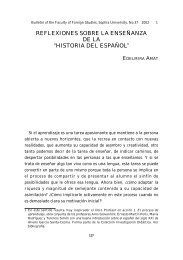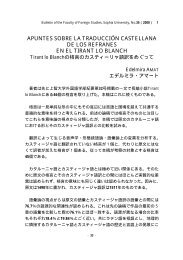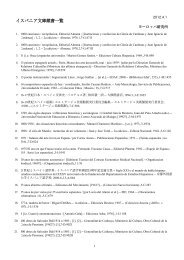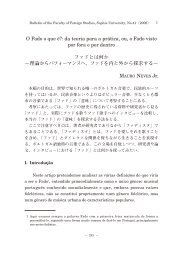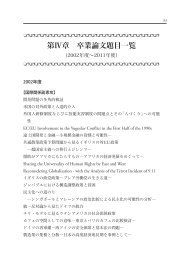Forgotten Paths to NEPA: A Historical Analysis of the Early ...
Forgotten Paths to NEPA: A Historical Analysis of the Early ...
Forgotten Paths to NEPA: A Historical Analysis of the Early ...
Create successful ePaper yourself
Turn your PDF publications into a flip-book with our unique Google optimized e-Paper software.
Joseph DiMen<strong>to</strong> and Kazu<strong>to</strong> Oshio<br />
waste dumps, and with <strong>the</strong> diminution <strong>of</strong> biological diversity, and destruction <strong>of</strong><br />
recreational opportunities.” They were blocked from taking any legal actions<br />
<strong>the</strong>mselves because “(unlike <strong>the</strong> polluters) <strong>the</strong>y had no conventional legal interests<br />
such as a property or contract right that <strong>the</strong> law was accus<strong>to</strong>med <strong>to</strong> protecting.”<br />
Sax provides a couple <strong>of</strong> examples:<br />
To assert a legal interest in protecting <strong>the</strong> survival <strong>of</strong> <strong>the</strong> peregrine falcon or<br />
<strong>the</strong> grizzly bear was <strong>to</strong> be seen as a busybody. To complain about contamination<br />
was <strong>to</strong> be dismissed as a scientific naïf. And if by some near miracle<br />
one did get a foothold in a court or an administrative proceeding, <strong>the</strong> response<br />
was a tidal wave <strong>of</strong> motions, objections, depositions, and all o<strong>the</strong>r<br />
legal techniques <strong>of</strong> <strong>the</strong> war-<strong>of</strong>-attrition. 33<br />
The urgent need <strong>to</strong> take a preventive stance as <strong>to</strong> environmental hazards, <strong>the</strong><br />
need <strong>to</strong> equip <strong>the</strong> public agencies <strong>to</strong> do <strong>the</strong> work, and <strong>the</strong> difficulties and costs <strong>of</strong><br />
obtaining information were <strong>the</strong> three major obstacles that helped <strong>to</strong> initiate “farreaching<br />
and fundamental legal reform,” concludes Sax, which “led <strong>to</strong> <strong>the</strong> enactment<br />
<strong>of</strong> <strong>the</strong> National Environmental Policy Act.” “The notion that ordinary<br />
citizens could go <strong>to</strong> court,” he continues, “even though <strong>the</strong>y did not have ownership<br />
<strong>of</strong> <strong>the</strong> resources <strong>the</strong>y were trying <strong>to</strong> protect, was embodied in a variety <strong>of</strong> socalled<br />
citizen suit provisions.” 34<br />
Indeed, Sax had a huge influence on <strong>the</strong> law. His writing has been cited by <strong>the</strong><br />
Supreme Court nine times, by federal appellate courts seven times, and by thirty<br />
state supreme courts. His scholarship not only identified <strong>the</strong> obstacles <strong>to</strong> environmental<br />
protection law but also his<strong>to</strong>rical common law traditions <strong>to</strong> be used <strong>to</strong><br />
address <strong>the</strong>se concerns. Fur<strong>the</strong>rmore, he participated in <strong>the</strong> meetings that led <strong>to</strong><br />
<strong>the</strong> creation <strong>of</strong> <strong>the</strong> Environmental Law Institute, <strong>the</strong> launch <strong>of</strong> <strong>the</strong> Environmental<br />
Law Reporter, and <strong>the</strong> legislative proposal that would eventually become <strong>NEPA</strong><br />
in 1969. Thus, in short, Sax was said <strong>to</strong> have helped launch <strong>the</strong> “environmental<br />
decade.” The task <strong>of</strong> environmental law scholars <strong>to</strong>day, Lazarus <strong>of</strong> <strong>the</strong> George<strong>to</strong>wn<br />
Law Center urged, is <strong>to</strong> safeguard <strong>the</strong> legal architecture that legal scholar Sax’s<br />
work helped inspire.<br />
In response <strong>to</strong> <strong>the</strong> above stated problems, <strong>the</strong> judicial branch played a critical<br />
role in solving <strong>the</strong>m. The courts had indeed a crucial function and acted in<br />
collaboration with or sometimes independent <strong>of</strong> Congress. According <strong>to</strong> Lazarus,<br />
many judges viewed environmental lawsuits as akin <strong>to</strong> <strong>the</strong> civil rights suits:<br />
29






